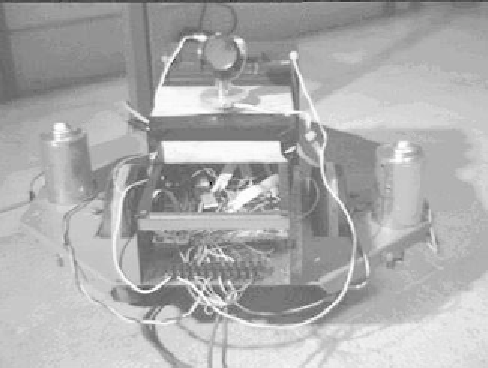Biomedical Engineering Reference
In-Depth Information
concepts can be used to obtain controllers that
adapt robot's behaviour according to its sensory
input, focusing on scaling up during the path
generation task in an unknown environment. A
frequently used strategy to implement the scaling
up of behaviours is the Layered Evolution (LE)
(Togelius, 2003). It provides satisfying results in
cases where some of traditional methodologies
failed. Based on a comparison between Incre-
mental Evolution (Urzelai & Floreano, 1999)
and Modularized Evolution (Calabretta, Nolfi &
Parisi, 2000), (Nolfi, 1997), LE uses the concept
of subsumption architecture in the evolutionary
process, (Brooks,1986), (Téllez & Angulo, 2004).
Key concepts in LE are Modularity (Nolfi &
Floreano, 2000), Adaptability (Di Paolo, 2000-
2003) and Multiplicity. LE proposes an evolution
sequence from bottom layers (basic behaviours)
to upper levels (complex behaviours). A different
fitness function is created for each level. Only
when evolution on a given level reaches a suitable
fitness score, a new (upper) level is created and the
lower level gets frozen. Evolution then continues
on the new hierarchical level. A
Coordination
Structure
is a key point, necessary to coordinate
emergent behaviours. It can be generated in several
ways (e.g., expert user knowledge, as a part of
an evolution process, or by mean of an artificial
immune system).
These ideas will be illustrated with an experi-
ment using artificial evolution in autonomous path
generation devised for the Khepera
©
micro-robot
in the third case study presented in the sequel. In
this way, the next case studies show the progress
from traditional AI and CI approaches to bio-in-
spired ones, which seem the most promising.
APPLICATION EXAMPLES
A traditional approach with a central world model
to achieve path planning is analyzed firstly. The
practical problem consists on the autonomous
guidance and control of a terrestrial vehicle in a
completely unknown environment. The
autono-
mous guided vehicle
(AGV) of Figure 1 was used
as the non-holonomic experimental platform.
The method proposed combines optimum
path planning techniques with fuzzy logic to
avoid obstacles and to determine the shortest
Figure 1. Autonomous guiding vehicle with a planning module based on Dijkstra's algorithm, and fuzzy
logic based guidance and control systems

Search WWH ::

Custom Search